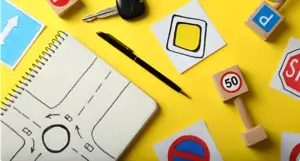Did you know that every year, over 1.35 million people lose their lives in road traffic accidents? It's a staggering statistic that highlights the importance of staying safe on the road.
Whether you're a seasoned driver or just starting out, it's crucial to prioritize your safety and the safety of others. In this article, we will provide you with 8 important safe driving tips that can help reduce the risk of accidents and keep you and your loved ones protected.
From maintaining a safe following distance to avoiding distracted driving, these tips will empower you to make smart decisions behind the wheel.
So let's dive in and learn how to stay safe on the road!
Maintain a Safe Following Distance
How closely should you follow the vehicle in front of you to ensure a safe distance? Maintaining a safe following distance is crucial for road safety. By keeping an appropriate distance between your vehicle and the one ahead, you allow yourself enough time and space to react to any unexpected situations. Defensive driving techniques emphasize the importance of maintaining a safe following distance to minimize the risk of accidents.
To determine a safe following distance, the general rule is to maintain at least a three-second gap between your vehicle and the one in front of you. This gives you enough time to react if the vehicle ahead suddenly brakes or encounters any other hazards. However, in certain situations, such as adverse weather conditions or heavy traffic, it's recommended to increase this gap to four or more seconds.
Maintaining a safe following distance isn't only about avoiding collisions but also about being considerate towards other drivers. Tailgating can cause anxiety and stress for the driver in front, potentially leading to erratic behavior and putting everyone on the road at risk. By maintaining a safe distance, you create a safer driving environment for yourself and others.
Avoid Distracted Driving
When it comes to staying safe on the road, avoiding distracted driving is crucial. One major source of distraction is cellphone use while driving, which can take your attention away from the road and increase the risk of accidents.
It's important to understand the potential distractions and consequences of using your cellphone while driving to ensure your safety and the safety of others on the road.
Cellphone Use While Driving
To avoid distracted driving, always refrain from using your cellphone while operating a vehicle. Cellphone use increases the risk of accidents because it takes your attention away from the road. It can lead to delayed reaction times, impaired judgment, and decreased situational awareness.
The consequences of distracted driving can be severe, and using a cellphone while driving is one of the most common forms of distraction. Texting, browsing social media, or even talking on the phone can divert your attention from the road and increase the likelihood of an accident.
It's important to prioritize your safety and the safety of others by keeping your cellphone out of reach while driving. Remember, no call or text is worth risking your life or the lives of others on the road.
Potential Distractions and Consequences
Refrain from engaging in potential distractions while driving to prevent accidents and ensure your safety. Distracted driving consequences can be severe and life-altering, making it crucial to avoid distractions while driving. One of the most common distractions is cellphone use, which includes texting, talking, or browsing the internet.
However, distractions can come in various forms, such as eating, grooming, adjusting the radio, or even daydreaming. These distractions take your attention away from the road and increase the likelihood of an accident.
To avoid distractions while driving, it's essential to practice good habits, such as putting your phone on silent or in a designated holder, planning your route in advance, and focusing on the task at hand – driving. By staying alert and eliminating potential distractions, you can significantly reduce the risks associated with distracted driving.
Observe Speed Limits
By adhering to posted speed limits, you can ensure the safety of yourself and others on the road. Speed limits are set for a reason – to prevent accidents and maintain order on the roads. Exceeding the speed limit not only puts you at risk, but it also endangers the lives of others around you. When you drive too fast, your reaction time decreases, making it harder to avoid obstacles or sudden changes in traffic. It also increases the severity of any potential accidents.
Additionally, driving at high speeds can lead to road rage incidents, as other drivers may become frustrated or angered by your reckless behavior. To avoid road rage, it's crucial to stay within the speed limits and drive responsibly.
Another important aspect of safe driving is checking blind spots. Blind spots are areas around your vehicle that can't be seen in the rearview or side mirrors. Failing to check blind spots before changing lanes or making turns can result in collisions with other vehicles. Therefore, it's essential to always check your blind spots by turning your head and looking over your shoulder before making any maneuvers.
Obeying speed limits and checking blind spots are simple yet critical practices that can greatly contribute to road safety.
Use Turn Signals Properly
To ensure your safety on the road, it's crucial to use your turn signals properly.
This means signaling before changing lanes and indicating your intentions while turning.
Signal Before Changing Lanes
Always use your turn signals when changing lanes to ensure the safety of yourself and other drivers on the road.
Proper lane changing is a crucial skill for every driver, and using your turn signals is an essential part of it. Before changing lanes, it's important to check your blind spots. These are the areas alongside your vehicle that you can't see in your rearview or side mirrors.
By checking your blind spots and using your turn signals, you let other drivers know your intentions and give them enough time to react. This simple act of signaling can prevent accidents and promote a smoother flow of traffic.
Indicate Intentions While Turning
When changing lanes, it's important to indicate your intentions by properly using your turn signals. Signaling before turning is a crucial aspect of safe driving.
Many drivers make the common mistake of failing to use their turn signals, which can lead to confusion and accidents on the road. By using your turn signals, you're providing valuable information to other drivers about your intended actions. This allows them to anticipate your movements and adjust their driving accordingly.
Properly signaling also helps to maintain traffic flow and prevent unnecessary delays. Remember, signaling isn't just a courtesy, but a legal requirement in most jurisdictions. So, always make it a habit to use your turn signals in advance of any turn or lane change to ensure everyone's safety on the road.
Practice Defensive Driving Techniques
Stay alert and anticipate potential hazards by practicing defensive driving techniques.
Defensive driving skills are essential for ensuring your safety on the road. By adopting these techniques, you can reduce the risk of accidents and protect yourself and others.
One important technique is maintaining a safe following distance. This allows you to have enough time to react in case the vehicle in front of you suddenly stops or slows down.
Another technique is constantly scanning the road ahead, checking for any potential hazards such as pedestrians, cyclists, or debris. By doing so, you can anticipate and respond accordingly, avoiding any last-minute maneuvers.
Additionally, being aware of your surroundings and keeping an eye on other drivers' behavior is crucial. This enables you to anticipate their actions and adjust your driving accordingly.
Stay Alert and Avoid Fatigue
To avoid fatigue while driving, make sure to get enough rest before getting behind the wheel. Avoid drowsy driving by prioritizing sleep and maintaining a regular sleep schedule. Adequate rest is crucial for your alertness and concentration on the road. When planning a long trip, be sure to include regular rest breaks to give your mind and body a chance to recharge.
The importance of rest breaks can't be overstated. Taking breaks every two hours or 100 miles can help prevent drowsiness and improve your overall driving performance. During these breaks, stretch your legs, get some fresh air, and have a snack or a drink. Engaging in light physical activity can increase blood flow and help you stay alert.
If you start to feel drowsy while driving, don't hesitate to pull over and take a short power nap. Even a 20-minute nap can provide a significant boost in alertness. Avoid relying on caffeine or other stimulants as they may provide only temporary relief and can lead to a crash in energy levels later on.
Use Seat Belts and Child Restraints
Ensure your safety and the safety of your passengers by always using seat belts and child restraints. Seat belts are a crucial safety feature in vehicles that can significantly reduce the risk of injury or death in the event of a crash. They help to prevent occupants from being thrown forward or ejected from the vehicle during a collision. It's important to note that seat belt usage isn't only recommended but also required by law in many countries.
Child restraint laws mandate the use of appropriate child safety seats or booster seats for young children, depending on their age, weight, and height. These laws are in place to protect children and ensure their safety while traveling in vehicles. Seat belts and child restraints are designed to work together to provide the highest level of protection for occupants of all ages.
Regularly Maintain Your Vehicle
Keep your vehicle in optimal condition by regularly maintaining it. Regular vehicle maintenance offers several benefits that can help you stay safe on the road.
One important aspect of maintenance is checking your tire pressure regularly. Properly inflated tires improve traction and handling, which is crucial for safe driving. Underinflated tires can increase the risk of accidents and decrease fuel efficiency. By regularly checking and maintaining the correct tire pressure, you can ensure that your vehicle performs at its best.
Regular vehicle maintenance also includes checking and changing your oil regularly. Clean oil helps to lubricate the engine and prevent overheating, improving overall performance and extending the life of your vehicle. Additionally, regular maintenance helps identify potential issues before they become major problems. Checking your vehicle's fluids, such as coolant and brake fluid, ensures that they're at the right levels and functioning properly.
Another important aspect of regular maintenance is inspecting your brakes and replacing worn-out brake pads. Faulty brakes can significantly increase stopping distances and put your safety at risk. By addressing any brake issues promptly, you can maintain optimal braking performance and reduce the risk of accidents.
Frequently Asked Questions
What Are the Consequences of Not Maintaining a Safe Following Distance?
Not maintaining a safe following distance can have serious consequences. It's important to keep a safe distance from the vehicle ahead to avoid rear-end collisions and give yourself enough time to react.
How Can I Avoid Distractions While Driving?
To avoid distractions while driving, stay focused on the road and avoid using cellphones. Keep your attention on the task at hand and remember that it only takes a split second for an accident to happen.
What Are the Potential Risks of Not Observing Speed Limits?
Not observing speed limits can have serious dangers and consequences. It increases the risk of accidents, reduces your ability to react to unexpected situations, and could result in fines, license suspension, or even imprisonment.
Are There Any Specific Rules or Guidelines for Using Turn Signals Properly?
Using turn signals is crucial for safe driving. Proper turn signal etiquette includes using your signals in advance of making a turn or changing lanes, and ensuring they are clearly visible to other drivers.
How Can I Practice Defensive Driving Techniques Effectively?
To practice effective defensive driving techniques, focus on staying alert, maintaining a safe following distance, and anticipating potential hazards. Use your mirrors frequently, signal your intentions, and always obey traffic laws. Stay vigilant and prepared for any situation on the road.






